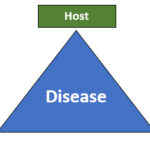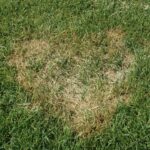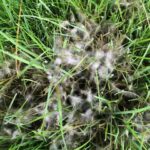Table of Contents
ToggleLast Updated on April 18, 2025
Each year homeowners call about areas of their lawn turning brown or dying and want us to come evaluate the problem. There are several different things that could be causing the issue; however, disease is the most questioned and misunderstood diagnosis. What causes lawn disease? The environment is the biggest factor in why your lawn gets disease. In this blog, we are going to dive in a little deeper and help you understand exactly which environmental conditions are to blame.
Before we get into the different environmental conditions, let’s first discuss how plants get infected. The disease triangle below is not just for turf, but all plants susceptible to disease.
All three corners of the disease triangle must be present for the disease to occur. The host is a plant susceptible to disease. The pathogen is typically a fungus for most lawn diseases. The environment refers to the conditions that a specific disease needs to enter a plant.
The Host
For turf, defining the host is easy, it’s the types of grass varieties you have on the property. All grass varieties are different, and some are more susceptible to certain diseases than others. Knowing the grass variety will help you narrow down the list of potential diseases you need to be on the lookout for.
New grass varieties are constantly being developed that are marketed as more resistant to disease. We will touch on using these new varieties later in the blog, but it’s important to note that these varieties are resistant, NOT IMMUNE, so disease can still infect the plant. The same holds true for resistant trees and shrubs, just because they are resistant, does not mean those trees and shrubs will never get disease.
The Pathogen
The pathogens that cause lawn disease are typically fungus but can also be bacteria or virus. The fungus needs to be present in the soil, it gets there by creating spores that get moved by wind or are carried over by animals. Pathogen presence is not in our control, so for this blog we will just assume the pathogens are in the soil.
The Environment
The environment is the final corner of the disease triangle and the most critical. There are certain practices we can follow to minimize environmental impacts. For turf, fungal pathogens can enter the plant when two conditions are present. The first is temperature, most fungal pathogens prefer warmer weather, above 70 degrees Fahrenheit during the day, but more critical are temperatures at night. Depending on the actual fungus, most need nighttime temperatures to be above 55 degrees. The second condition is moisture, pathogens can enter the host when the leaf tissue is wet. This means your lawn is most susceptible to disease when the nighttime temperatures are high and it’s raining or very humid. We can’t control the weather, so if we get the right environmental conditions, disease can become an issue. The past two seasons in New Jersey were not typical with respect to the large amounts of rainfall we received, especially during the late summer and early fall months. Both years we also saw a large spike in disease activity, not only on home lawns but on sports fields and golf courses as well.
What Can We Do?
So, if I can’t control the weather, the pathogen is already in my soil, and the host is susceptible, is there anything I can do? Absolutely! Let’s start by looking at the moisture portion of the environment. This is very important, especially if you have irrigation. If the temperatures at night are above 55 degrees and you have your irrigation set to water every single day for 30 minutes, you are creating the perfect environment for disease by getting the leaf tissue wet every day! Watering correctly is critical, especially when the temperatures are ideal for disease. You want to water infrequently, between the hours of 12am and 6am are ideal because the grass is already wet from dew formation. A good starting point is to water your lawn only twice per week at approximately 1 hour per zone between 12am and 6am. This only a starting point and will change depending on the weather, for more detailed watering instructions click here for a blog on proper watering schedules.
Still focusing on moisture, we need to look at a few other things. Is your soil compacted? If so, the water will remain on the surface, taking longer to drain into the ground. Improve drainage by aerating your lawn at least every other year or even more often if it’s severely compacted. Grading also plays a role, lower sections of turf will retain moisture longer, making it more likely for a pathogen to enter and infect those plants. Have a landscaper improve the grading to get even run off and minimize the pooling of water in low areas.
Seeding
Hopefully by now, you understand how the environment plays a key role in causing lawn disease, especially moisture! If you have addressed the moisture issues above and disease is still an issue, another option to try is overseeding with a newer variety of turf. You’ll want to pick a variety that is more disease resistant and made for the environment you are seeding (sun seed in the sun, shade seed in the shade). Plants that are already under stress are more likely to get infected by a pathogen than those that are healthy. This means that your shade loving grass variety planted in the full sun will be really stressed out in the summer heat and more likely to get disease each year. Use seed that is right for the environment you are planting in, try to avoid the generic “Sun and shade mixes” if possible. Remember, disease resistance does not mean immune!
Chemical Control
Another option for battling disease is chemical control with a fungicide. Some diseases attack the roots, by the time you see the impacts on the surface, it is too late to treat, and preventative control should be considered in the future. Other diseases can be treated, most foliar diseases can be stopped for approximately 30 days with a fungicide. A very common question with fungicides is “Is this it, or will I need another fungicide?” The answer to that all depends on…yup you guessed it, the weather! After 30 days, if the lows at night are above 55 degrees and its very humid or rainy, then the disease could become active again.
One of the main barriers to applying fungicides is cost. Fungicides are some of the most expensive products in the lawn care industry. If you have zero tolerance for disease in your lawn, then monthly preventative fungicide treatments in the late spring and summer is the way to go, but it’s not cheap. Another option is to hold off until the forecast shows favorable disease conditions. At that point you can have a fungicide applied to protect the turf for 30 days. The final option is to treat the disease after it has already infected the plant. This will stop the disease from spreading for approximately 30 days and it’s important to treat it as soon as possible. The longer it’s active, the less likely it is for the infected plants to recover. Waiting to treat after the plant is infected is not always an option, for some diseases it’s either too late or no products exist to effectively stop the spread. Your lawn care provider can diagnose the disease and let you know what options are available. You can also have a sample of your turf tested to confirm disease is the culprit.
Conclusion
Hopefully, you have a better understanding of what causes lawn disease after reading this blog post. If you’re in our service area and have questions about disease, or anything lawn care related, please give our office a call at 908-281-7888.




